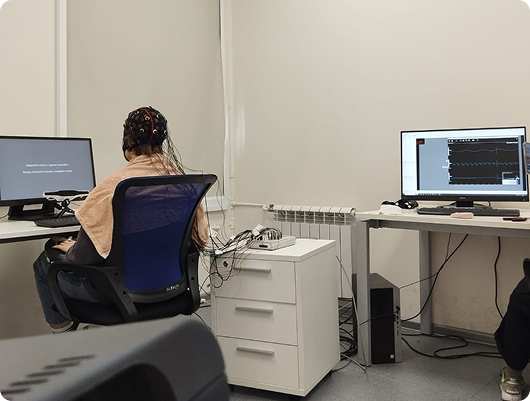The first phases of a pilot scientific study of the GSR phenomenon have been completed.
The research was conducted by the Center for Bioelectric Neurointerfaces of the National Research University Higher School of Economics (HSE) under the supervision of Professor, Doctor of Sciences A.E. Osadchy in partnership with the Brainstart company, a resident of the Skolkovo Foundation.
The project was based on three key principles:
- Compliance with modern scientific standards.
- Strict compliance with the law.
- Maximum objectivity - including a control (placebo) group.
Today we are ready to share with you the first results of the study.
A study of the impact of GSR practice on human electrophysiological parameters
During the study, full GSR sessions were conducted with the participation of an experienced specialist. Using the GSR technique, a symptom was "wound up", after which a session was conducted. During the session, as well as before and after the work, the physiological and psychological parameters of the participants were recorded according to the following parameters:
- galvanic skin response (GSR),
- photoplethysmogram (PPG),
- electromyography (EMG),
- oculography,
- respiratory activity,
- electroencephalogram (EEG),
- psychological questionnaires (PANAS, STAI).
The research methods are scientifically proven and accepted in international practice. They are reproducible and, taken together, provide high statistical reliability of the results.
These methods allow not only to record subjective sensations, but also to measure real changes in the human body and brain that occur during deep internal work. With their help, one can objectively observe how they are reflected in the body's reaction, in the brain's work, in physiology and emotional state.
Research has proven that a GSR session:
- relieves stress;
- significantly relaxes physiologically;
- increases the power of the theta rhythm of the EEG in the frontal region of the cerebral cortex;
- facilitates control over automatic emotional behavior, helping to suppress habitual emotional reactions in favor of more conscious actions;
- positively correlates with the success of emotion regulation strategies, especially those such as cognitive reappraisal;
- may be associated with a reduction in the tendency toward addictive behavior and improved emotional well-being.
Conclusion:
The GSR technique is able to effectively activate self-referential and regulatory processes, which makes it a potentially useful tool in psychotherapeutic practice.

Scientific work is an important step towards integrating GSR into the social field.
We will continue this direction and keep you updated.
We would like to thank everyone who participated: GSR specialists, organizers, subjects, and Dmitry Ustinov, the author of the methodology, whose ideas formed the basis of the research design.
If you plan to publish this research in the media, distribute this information to a wide audience, or contact government agencies, please coordinate this with the GSR administration in advance.